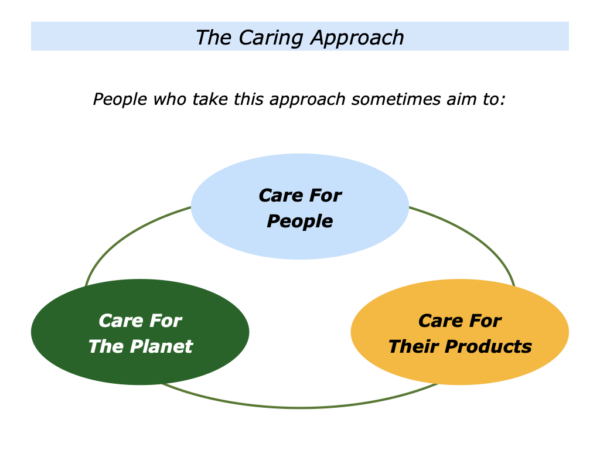
There are many ways to live life. Some people aim to follow the caring approach rather than the cruel approach. The route they follow has consequences – both for themselves and other people.
Different people follow the caring approach in different ways. They may focus on caring for people, for their products or for the planet. Some aim to combine all of these elements. Let’s explore these themes.
They Care For People
Some people aim to care for their loved ones and for other people. They are kind, encouraging and supportive. They have also often learned how to take care of themselves in a healthy way. This means that when they meet a person:
They believe it is always about helping the other person. It is not about themselves.
Such people often have a clear moral compass, however, and are clear on what they can and can’t do for other people. This means they do not become victims or enablers. They then do their best to help people to shape their futures.
They Care Their Products
Some people do work they care about. They believe in following certain ways of encouraging people, designing things, solving problems or doing other activities. They aim to do their best when helping people, providing services or creating products. They sometimes ask themselves:
How is this going to help people or the planet?
Such people do things they believe in. They do the basics and then add the brilliance. They may also follow some of the elements of great design. They may aim to make things simple – in a profound way – satisfying and successful.
They Care For The Planet
Some people aim to care for the planet. They may do practical things that encourage people, care for the environment or give hope to both and future generations.
Some people aim to share a positive paradigm. They try to show people a way of living or working that is practical and, in the widest sense, profitable. They show how it will benefit both people and the planet.
Imagine that you want to take some of these steps. You will do this in your own way, so let’s explore some of the ways it may be possible.
Caring For People
How can you continue to care for your loved ones? How can you continue to care for other people? Different people express caring in different ways. Some ask themselves the following questions before meeting a person.
Who is the person I am going to meet? What is happening in their world? What may be their goals? What may be the challenges they face? How can I make them the centre of my world? If appropriate, how can I encourage them in their lives and work?
Some people aim to care for others in their daily lives. Some aim to create positive environments in which people can thrive. Some gifted people pass on guidelines that other people can follow to do great work.
Dame Cicely Saunders, for example, helped to helping to create the modern hospice movement in Britain. She cared about helping people who were moving towards the end of their lives.
Cicely trained as a nurse but suffered a back injury that halted that career path. Overcoming the setback, she became a medical social worker and got a job at St. Thomas’ Hospital in London.
There she met a dying patient called David Tasma, whose plight revealed the lack of care for the terminally ill. A 40-year-old refugee from Poland, he was dying of incurable cancer.
David had no relatives so Cicely devoted many hours to talking with him about his life. Apart from exploring his feelings, they discussed the need to create special facilities for people who were dying. Denise Winn takes up the story in her book The Hospice Way.
Although the hospital did its best, David suffered much pain and discomfort, both physical and mental. It was then that Cicely first mooted the idea of building a special hospital herself, to cater specifically for the very different needs of the terminally ill.
David was thrilled to be the inspiration for such an idea and when he died he left her all his money (£500), saying ‘I’ll be a window in your home.’
Cicely embarked on her mission. She studied to become a doctor and served in several posts. She then began raising the £500,000 necessary to build a specially designed hospital with highly qualified staff.
Ten years later she achieved her vision with the opening of St. Christopher’s Hospice in South London. Denise Winn wrote describing it in the following way.
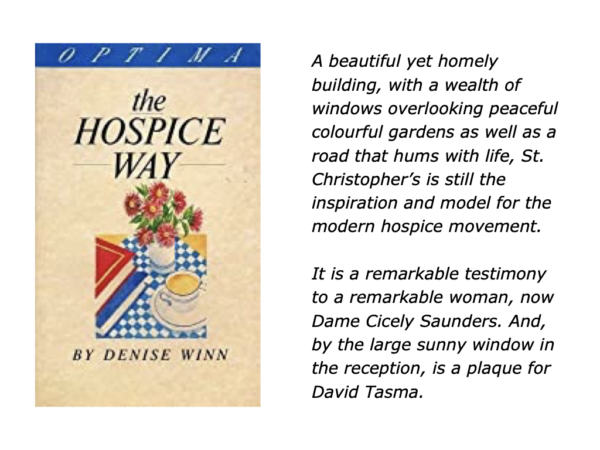
Caring For Products
What are the kinds of work you really care about? When do you do work that gives you positive energy? What are the kinds of work you find satisfying? When do you flow, focus, finish and find fulfilment?
When do you do work where you build on your strengths, follow strategies that work and achieve success? How can do more of this in the future? What will be the benefits for people or the planet?
People who care about what they are doing are more likely to do fine work. They believe delivering consistently high standards when helping people, providing a service or creating products.
Such people often start by choosing to do work they really care about. Here are some answers that individuals may give when exploring this theme.
The Kinds Of Work I Really Care About Are:
Helping children who are dyslexic … Growing organic food … Providing young people with sports experiences that help them to develop … Running events that give people positive memories for life.
Working as a paramedic … Making films that inspire people to care for nature … Designing beautiful buildings … Creating user-friendly software … Passing on knowledge that helps people to succeed.
Different individuals follow different models to put their heart and soul into the work. Bearing in mind they thing they really care about, some people focus on the following themes.
Clarity
Such people start by establishing clarity. They sometimes do this by exploring the following questions.
What is the kind of work I really care about? How can I pursue this theme? What may be the piece of work I want to do to encourage people, provide a service or create a product?
What are the real results I want to achieve? What is the picture of success? What may be the benefits of doing such work? How may it help people or the planet?
Creativity
Such people then plan how to do the work. Sometimes this involves focusing on both what they know works and also potential creative possibilities. They may do this by exploring the following questions.
What are the possible options I can follow to perform the work? What are the pluses and minuses of each option? What is the attractiveness rating of each option? What are the other potential creative solutions?
What is the route – or combination of routes – I want to pursue? What are the key strategies I can follow to give myself the greatest chance of success? How can I translate these into a clear action plan?
Concrete Results
Such people move onto doing the work. Bearing in mind the results they want to achieve, they may take the following steps.
They keep following their chosen strategies, get some quick successes and do superb work;
They keep reading reality by focusing on: a) what they are doing well and how to do more of these things; b) what they can do better and how;
They keep finding solutions to challenges, do their best to reach the goals and add that touch of class.
Jürgen Griesbeck is somebody who followed elements of this approach. Spurred on by a tragedy, he developed Fútbol por la Paz (Football for Peace) in 1996. This was a project using football to combat violence and drugs on the streets of Medellín, Colombia.
Based on this experience, he created Straßenfußball für Toleranz (Street Football for Tolerance) in Brandenburg, Germany. His next step was to create streetfootballworld in 2002.
This harnesses the power of football to create environments that empower people to shape their future lives. Every year it reaches more than 2 million people in over 90 countries.
Running tournaments in local communities across the world, it uses football to bring people together. People make connections and combine their talents to tackle other challenges they face. Here is an introduction from their website.
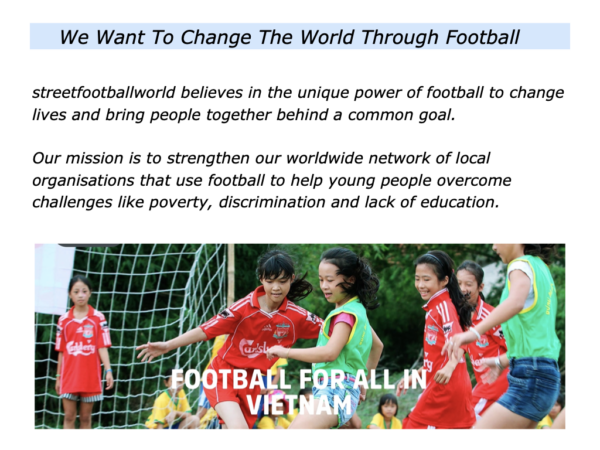
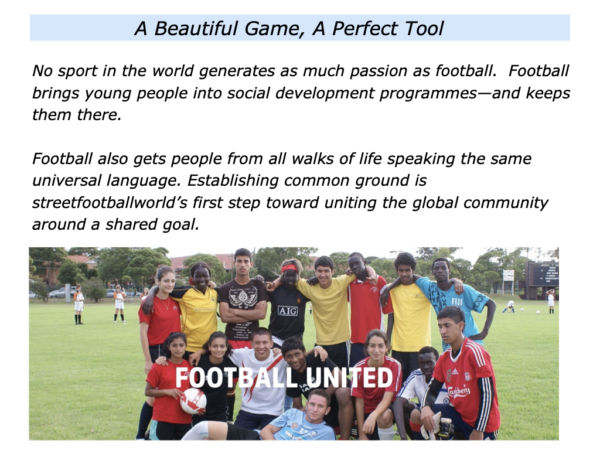
Jürgen went on to work with Juan Mata, the Spanish footballer, and in 2017 they founded Common Goal. This invites those involved in football to pledge 1% of their salaries to support disadvantaged young people.
Many players, managers and other people have pledged to support the venture. Here is an excerpt from the Common Goal website.
We’re uniting the world of footballers behind a shared commitment to give back. The idea is simple. Players pledge a minimum of 1% of their wages to a collective fund. And we allocate this fund to football charities that create the greatest impact worldwide.
Imagine uniting the world of football behind a shared social vision. Imagine the impact we could create and the lives we could change. 1% may seem like a small figure, yet it stands to make a big difference.
If the entire football community pledged just 1% of its collective income to a movement like Common Goal, we would generate a colossal 400% increase in funding for high-impact football NGOs the world over.
This translates to an additional eight million disadvantaged young people gaining access to football-based development projects each year. Through Common Goal, this is what we are trying to achieve. And we want you to join us.
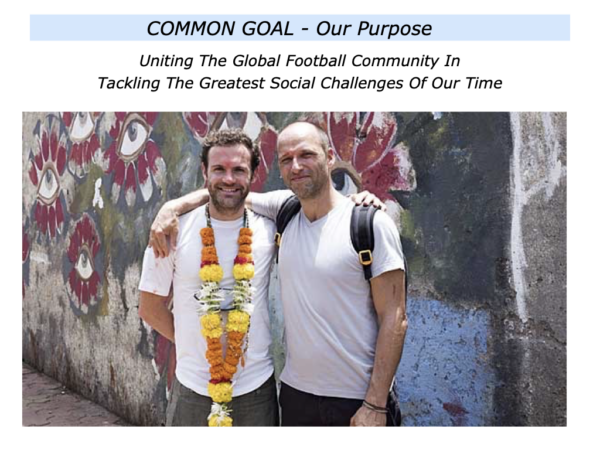
Caring For The Planet
Some people focus on caring for the planet. They may do practical things that encourage people, care for the environment or give hope to both and future generations.
Such people often invest enormous amounts of emotional energy into their work. Staying sane therefore calls for them remembering one key rule. They can focus on what they can control rather than what they can’t control. They are then more likely to be able to see things in perspective.
Wangari Maathai was somebody who took this approach. Best known for her work with the Green Belt Movement in Kenya, she recruited hundreds of thousands of people who planted more than 40 million trees.
She was born in 1940, the third of six children, in a traditional mud hut with no electricity or running water. Wangari said that she was fortunate because her family sent her to a primary school run by Italian nuns.
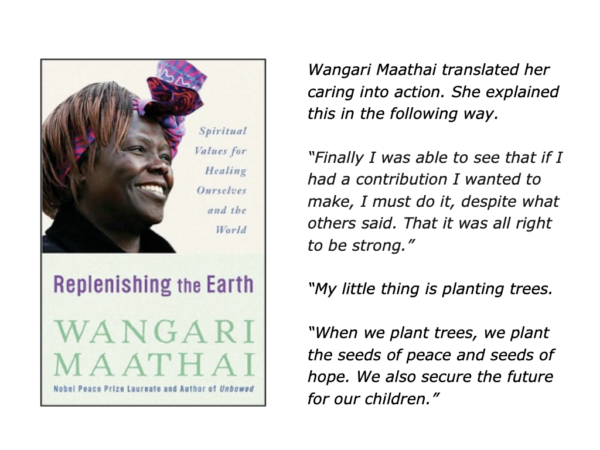
Showing great academic aptitude, she won a scholarship to the United States, being part of what was called The Kennedy Airlift. This involved some 300 Kenyans being chosen to study at American Universities.
After further study in Germany, she returned to Kenya. After working as a vet in some of the poorest areas, Wangari led academic departments in the University of Nairobi.
Extremely practical and logical (she was the first Kenyan woman to gain a Ph.D.), her work sprang from a philosophical base. She believed it was vital to live in harmony with nature and described this in the following way.
“We must repent our sins (i.e. rectify our wrongdoings) by dressing our motherland in her original beautiful and full green dress. In planting trees, we are adorning our motherland with belts. When we have done this our motherland will be healed and we shall reap a bounteous harvest.”
Wangari was often asked if the idea for the Green Belt Movement came to her because she was a woman. Acknowledging that women bear life and respect nature, she said it was simply searching to solve a specific problem.
This involved helping people to climb out of poverty, replenish the earth and enjoy the fruits of their labours. She described this in the following way.
Inspirations come to all of us but many of us may not have the right mental peace and tranquillity at the critical time to allow the inspiration to grow beyond the stage when it appears like a dream.
I think I was just lucky. I do not know why I nursed the inspiration until it became an idea and finally an activity. I think that women in the NCWK (National Council of Women in Kenya) were quite good at pursuing an idea which for a long time bore little fruit. But patience is not the prerogative of women.
Tree planting became an honourable activity in Kenya, said Wangari. This led to creating thousands of greenbelts in the country and soon spread to other countries in Africa.
The act of planting trees enabled the earth to breathe and the crops to grow. Showing it was possible to make a difference encouraged people to take more charge of shaping their futures.
Wangari achieved much in her life before her death in 2011. By then she was acknowledged as a pioneer and honoured in many countries. She also won the Nobel Peace Prize.
Let’s return to your own life and work. Looking ahead, can you thinkof a specific activity where you may want to follow elements of the caring approach? How can you do this in your own way?
If you wish, try tackling the exercise on this theme. This invites you to complete the following sentences.
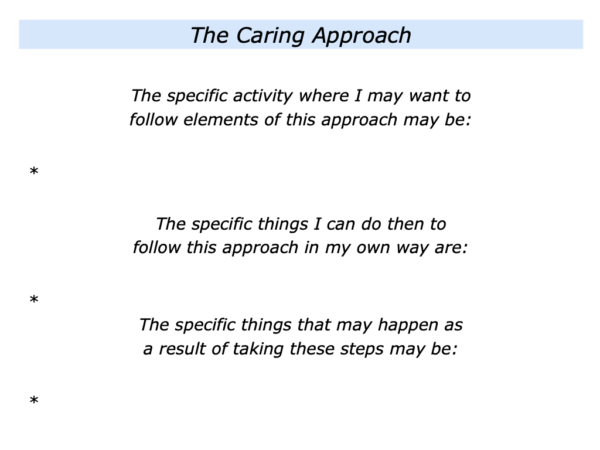






Leave a Reply